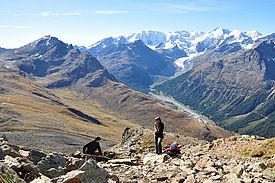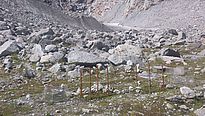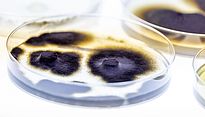Alpine microorganisms and climate warming (AlpBioClimDiv)
2023 - 2026
FinancingThe rapid retreat of glaciers and the thawing of permafrost are unfortunately a reality due to global warming. Areas covered by glacier ice form new habitats after melting and are of major importance for the biodiversity of the Swiss Alpine region. The progressive colonisation of these pioneer habitats by bacteria, viruses, fungi, mesofauna and plants have a strong influence on local and regional biodiversity in the Alps which can be studied by means of long-term observations and field experiments.
The Swiss Alps are one of the regions most threatened by climate warming. The resulting increase in glacier melt and the thawing of permafrost are contributing to a change in biodiversity in the Swiss Alps. Many species are threatened by the rising temperatures, while new species arrive in the changing habitat. Moreover, viruses and microorganisms that have been trapped in permafrost and ice for hundreds and thousands of years are being released, further changing the biodiversity in the Alps.
The interdisciplinary project AlpBioClimDiv investigates the microbial diversity in permafrost, glacier ice and glacier forefields in the Swiss Alps. Many of the organisms in these endangered habitats and their adaptations to the changing environment have hardly been investigated and are now being studied in more detail.
A large proportion of the fungi and bacteria that colonise newly formed glacier forefields after the ice melts originate from glacier ice. Glacier ice is therefore an important reservoir for past and present microorganisms and can now be analysed using cutting-edge sequencing technology. We now want to explore this completely unknown biodiversity to gain an insight into the microbiome and virome of melting glaciers.
Permafrost, which thaws due to rising temperatures, is another aspect of changing alpine microbial diversity. The targeted and controlled thawing of permafrost in experiments can provide insights into the existing biodiversity and its ability to adapt to warmer temperatures.
Unknown microorganisms in permafrost and glacial ice are part of a transient ecosystem worth protecting and often have their own unique metabolic characteristics and products. Among the unknown organisms that we cultivate in the lab are fascinating candidates with interesting biotechnological potential, for example, have useful enzymes for food technology and the plastics industry such as the degradation of synthetic polymers useful in circular economy as well as the production of new antibiotics for the pharmaceutical industry. With this project we want to build an inventory of organisms ('Biobank') from these ecosystems. This unknown treasure of microbial biodiversity from the permafrost and ice of the Swiss Alps is to be made accessible for future generations as well as for research and industry.
Frequently asked questions
- How is the microbial diversity in the Alps changing as a result of glacier retreat?
Newly exposed soil due to glacier melting is quickly recolonised by fungi, bacteria, soil animals and plants. These often originate from lower altitudes and can now be introduced into the glacier forefields. On the other hand, many organisms that have adapted to life in the ice cannot adapt to the changing environment, are weak competitors and disappear. This interplay often leads to a local increase in species diversity in newly formed soils, but measured over the entire Alpine region, the biodiversity may change and can even decrease.
Projects
Publications
Articles in the media
-
Aktionspläne des Kanton Glarus für den Artenschutz gefährdeter Lebewesen, 27.11.2022: Artenschutz - Kanton Glarus
-
Deutschlandfunk (Radio), 04.12.2021: Folgen des Klimawandels / Die Alpen in Bergnot
-
OggiScienza, 25.11.2021: Vita tra i ghiacci
-
Akademischer Workshop über Berge und Klimawandel, Einladung der Schweizer Botschaft in Belgien, Gent, 23.01.2020, The Unexplored Alpine Microbiome and their Reactions to Climate Warming.




